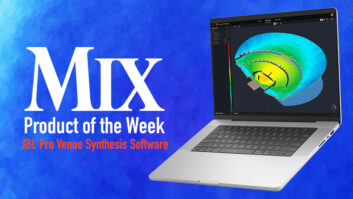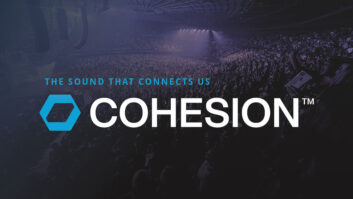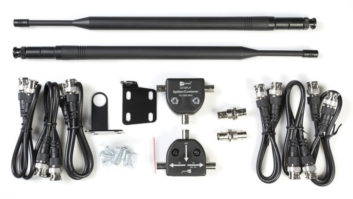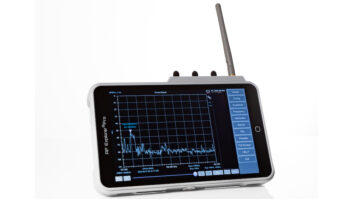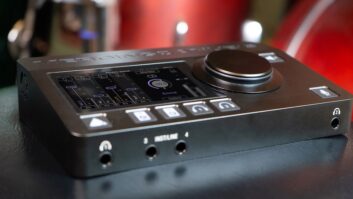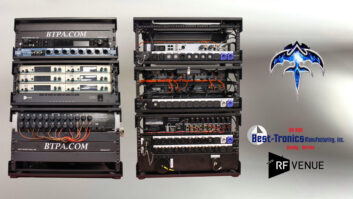The audio needs of nightclubs, theaters and houses of worship might appear to be different, yet, like other pro audio applications, they are increasingly converging onto technology platforms that are becoming common across the industry.
“Everything is IP,” says Ben Davis, an Arizona-based sales engineer for Sound Image. Specifically, “We’re seeing lots of integration with Dante. It’s doing away with any analog mult cable entirely,” he says.
Scott Kalata, director of sales for Masque Sound in New Jersey, agrees. Some venues and productions use AVB and he still encounters a lot of MADI. “But Dante seems baked in on almost every show, to a greater or lesser degree,” he says.
The fact that there is such a large catalog of Dante-enabled products available enables certain efficiencies for audio system operators. For example, says Kalata, “Some shows aren’t even using the console manufacturer’s mic input cards or using an input rack; they’re coming in over Dante from the digital wireless microphones that have Dante outputs.”
In Southern California, Michael Warren, president of MW Audio, reports that every system is centered around IP. “I think everything we do now is networking. Even if it’s a small venue, a church or a school auditorium, it’s usually a small digital console with at least an app controlling the system.”

Related: Learning at the Live House, by Tom Kenny, Oct. 29, 2018
Dante networks do have their advantages. As Kalata notes, “It makes things a little more efficient, a little smaller, a little lighter, more reliable and potentially less expensive.”
Nonetheless, challenges remain. For example, manufacturers of larger-format digital consoles allow for fiber connections, Davis says, yet they don’t all use the same connectors.
Any venue that caters to touring performers, secular or religious, has to be rider friendly, Davis continues. “You may have what you think is the coolest and greatest console in your venue, but the acts coming through have such a short amount of time that they want to be able to bring their console in with their show files already built. You have to give them the connectivity that allows for that.”
Warren cautions that not all Dante-enabled products are created equal. “You don’t know whose products are good and whose are not, except to put them in real-life applications and see what works and what doesn’t,” he says. Warren has had problems getting gear to work properly, he says, including some major-brand devices.
As for speakers, Sound Image is not limited to any one brand, says Davis, so he has access to a wide range of tools for his system designs. “Everybody wants a line array, whether a room needs one or not. There are a lot of really well-made products out there from every type of speaker manufacturer. They all have a different niche that they solve.”
Related: Connectivity Trends: AoIP, Wireless & Beyond, by Strother Bullins, Jan. 22, 2018

Offering an example, Warren says, “If you’ve got a church with a low ceiling, you get a VUE al-4; it’s a super tight array and it doesn’t hang really low. We don’t do point source anymore, but now you’ve got hybrid point source array boxes for smaller throws,” he says, from companies such as PreSonus. “That’s an interesting concept.”
With the adoption of Dolby Atmos and other object-based platforms by film and television content creators, and the recent announcements regarding the launch of immersive music streaming services, it seems likely that live sound venues will—perhaps must—follow suit. There are one or two examples, worldwide, of nightclubs, churches and theaters that have installed immersive systems from L-Acoustics, d&b audiotechnik and Dolby Laboratories, but Warren is not convinced that there will be a more general uptake anytime soon. “It’s a very hard sell. Budgets in a medium-size venue are going to be hard to find for immersive. Maybe in the future, when price points come down.”
Davis is rather more bullish about immersive audio’s prospects, and is at least discussing it with his church, theater and club clients. “It’s the next big change,” he predicts, not least because it’s being driven by consumers. Once people are used to having an immersive experience at home or on the move, he says, their expectations are going to be that much higher for live performances.
“That it’s becoming mainstream in a disc-less format is huge,” he says. “Once the consumer market starts generating revenue, it’s going to push it into our commercial industry.”
As a live sound mixer, Davis is excited for the creative potential that immersive audio promises. “This new technology is going to allow us to be able to deliver an amplified version of an instrument in a more coherent and realistic manner,” he says.
It could also serve a more practical purpose. “A lot of churches, especially older buildings, were designed around a style of worship that was more traditional,” says Davis, “with choirs and orchestras, and with large fan-shaped rooms with a stage thrust, where you can’t create a stereo environment for people, so you have to do exploded mono,” which creates coherence challenges. In contrast, he says, “Immersive opens up a whole new way of creating dimension in your mix. You have a lot more room in the mix instead of playing the volume game” in a stereo mix.
Related: AES67, AVB/TSN, Dante Power AoIP’s Rise, by Steve Harvey, May 25, 2018

There are considerations beyond the features and performance of the installed audio equipment, Warren comments. “Power gets overlooked, but it’s critical. For a small venue—500 people—we can do what we need to do off their 15- or 20-amp outlets, but there’s no way you can run a medium-size venue off 120 volts. It needs to be 230 volts, preferably three-phase.”
While a specialist is likely involved with acoustically engineering any larger venue or new build, Warren often tackles acoustic treatment for clients with smaller venues. “First I have to get the audio correct, then I get the room correct. We’ll shoot the room and figure out the anomalies. In churches with pitched roofs, we see a big issue around 338 Hz, so we’ve developed acoustical packages that deal with the ‘338’ issue,” he says.
Sound Image • www.sound-image.com
Masque Sound • www.masquesound.com
MW Audio • www.mwaudio.com
Want more stories like this? Subscribe to our newsletter and get it delivered right to your inbox.

